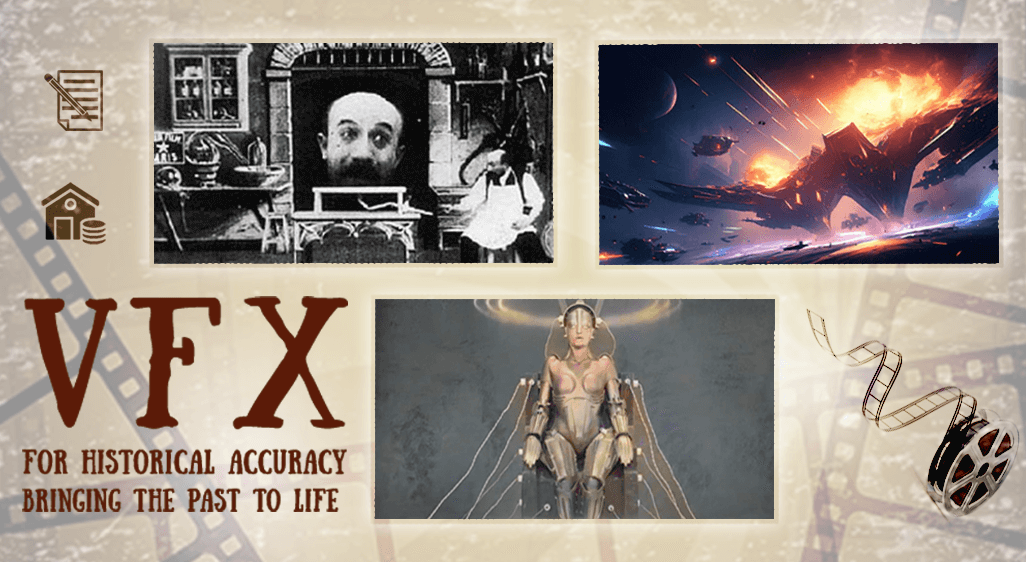The world of cinema is a realm where the boundaries between reality and imagination often blur. In this creative landscape, filmmakers embark on journeys to transport audiences to different times and places, breathing life into historical narratives. The challenge of recreating the past with historical accuracy has given rise to a fascinating intersection of art and technology, where Visual Effects (VFX) play a pivotal role.
In this blog, we will delve into the captivating world of VFX for historical accuracy, exploring how filmmakers use visual effects to resurrect long-lost architectural wonders, revive bygone eras, and breathe authenticity into their narratives. From the script to meticulous research, from artistic interpretation to technical wizardry, let’s embark on a journey through time and explore the art of bringing history to life on the silver screen.
The Cinematic World of Historical Recreation
At the heart of every historical film lies the desire to transport the audience to a different era, allowing them to experience history firsthand. Whether it’s the grandeur of ancient Rome, the elegance of Victorian London, or the mystique of the Renaissance, filmmakers strive to recreate these historical settings with precision and authenticity.
However, the passage of time can erase the physical remnants of these historical periods. Buildings crumble, landscapes transform, and the tangible connections to the past fade away. This is where VFX steps in as a powerful tool for filmmakers, enabling them to rebuild, reimagine, and rekindle the past. Here’s how VFX brings historical accuracy to the forefront:
Script Breakdown: The Blueprint for Historical Accuracy
The journey of historical recreation begins with a well-crafted script. Screenwriters, directors, and VFX supervisors collaborate to dissect the narrative, identifying crucial historical elements that demand meticulous recreation. This includes not only the architectural marvels but also the broader cultural and environmental context.
During this phase, decisions are made regarding the level of historical specificity required. Are wide shots sufficient, or do detailed close-ups demand a higher degree of historical accuracy? These considerations lay the foundation for the entire production process, guiding choices about what can be filmed on location, what needs to be digitally constructed, and what must be altered or removed.
Distinguishing Original from Modern
Before embarking on the journey of historical recreation, it’s essential to understand the degree of preservation or alteration present in the existing locations. This involves scrutinizing architectural styles, identifying older sections, and assessing the overall historical context.
Historical sources, such as paintings, artworks, books, and writings from the era in question, serve as invaluable references. Museums and exhibitions also offer a treasure trove of knowledge. Collaboration with experts in historical architecture further enhances the accuracy of the recreation.
Interestingly, similar films set in the same historical period can serve as a source of inspiration. Existing 3D models can be used as starting points, allowing VFX artists to build upon and modify them to align with the specific film’s vision.
Building the World: VFX as Historical Architects
Once the visual references are gathered and understood, the real magic begins. VFX artists take center stage, tasked with the responsibility of transforming these references into a believable historical world. The challenge lies in striking a balance between historical accuracy and artistic interpretation, all while aligning with the director’s vision.
This process is inherently iterative, with each step informing subsequent creative decisions. To achieve rapid results in the dynamic film industry, VFX artists employ various techniques, including sketching, speed painting, photo bashing, and 3D modelling.
Sketching involves quick, stylized representations of architectural elements, allowing for rapid exploration of ideas. Speed painting takes this a step further, focusing on composition, mood, and design. Photo bashing combines existing images to create new, historically accurate scenes. 3D modelling facilitates detailed pre-visualizations, enabling artists to explore texture, lighting, perspective, and camera movement efficiently.
The Role of Realistic Assets
From a technical perspective, the creation of realistic assets is paramount to achieving historical accuracy. Human perception operates contextually; we perceive buildings not as isolated components but as integral parts of their surroundings. Buildings have volume, reflect light differently, and cast shadows that contribute to their realism.
VFX professionals meticulously list and prioritize each visual element, identifying those that require perfection for close-ups or critical storytelling moments. These assets receive the most attention and effort. Background or filler elements, like out-of-focus skylines or facades, are often generated procedurally to maintain efficiency.
Collaboration and Creative Vision
The recreation of historical architecture in the film is not merely a technical feat but a creative endeavor. It demands a delicate balance between historical accuracy and artistic vision. This collaborative effort involves the director, production designer, visual effects supervisor, and digital artists working in harmony.
Together, they make decisions about how much of the original world to preserve, what elements to modify, and what aspects to invent. The ultimate goal is to craft a believable and immersive environment that serves the story, respects the historical and cultural context, and captivates the audience.
Breathing Life into History
The art of historical recreation through VFX is a testament to the power of storytelling and technology. It allows filmmakers to resurrect long-lost architectural wonders, revive forgotten eras, and immerse audiences in the tapestry of history.
From meticulous research to artistic interpretation, from technical wizardry to creative collaboration, VFX for historical accuracy is a multidimensional art form. It bridges the gap between the past and the present, bringing history to life on the silver screen.
As audiences continue to be enthralled by historical narratives, the role of VFX in historical accuracy will remain pivotal, ensuring that the past is not forgotten but instead relived in all its glory. The next time you find yourself transported to a bygone era while watching a historical film, remember the incredible artistry and technology that made it possible.












